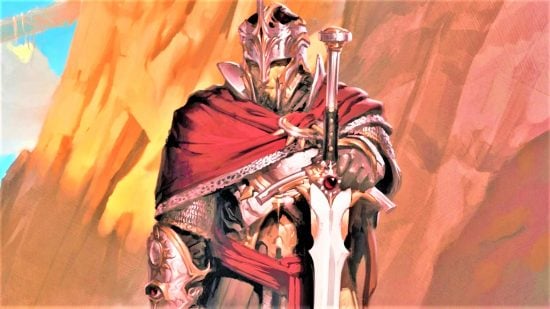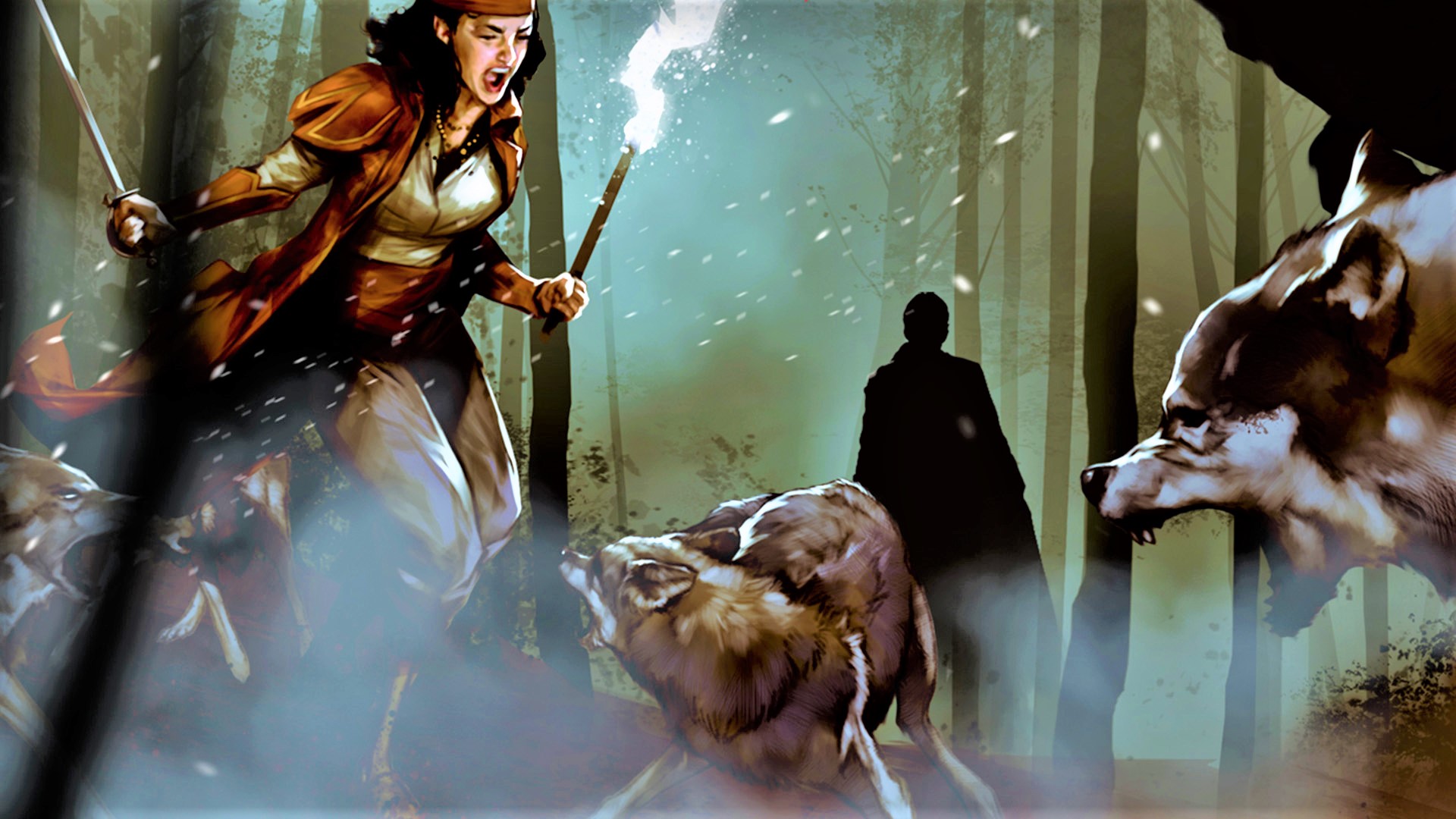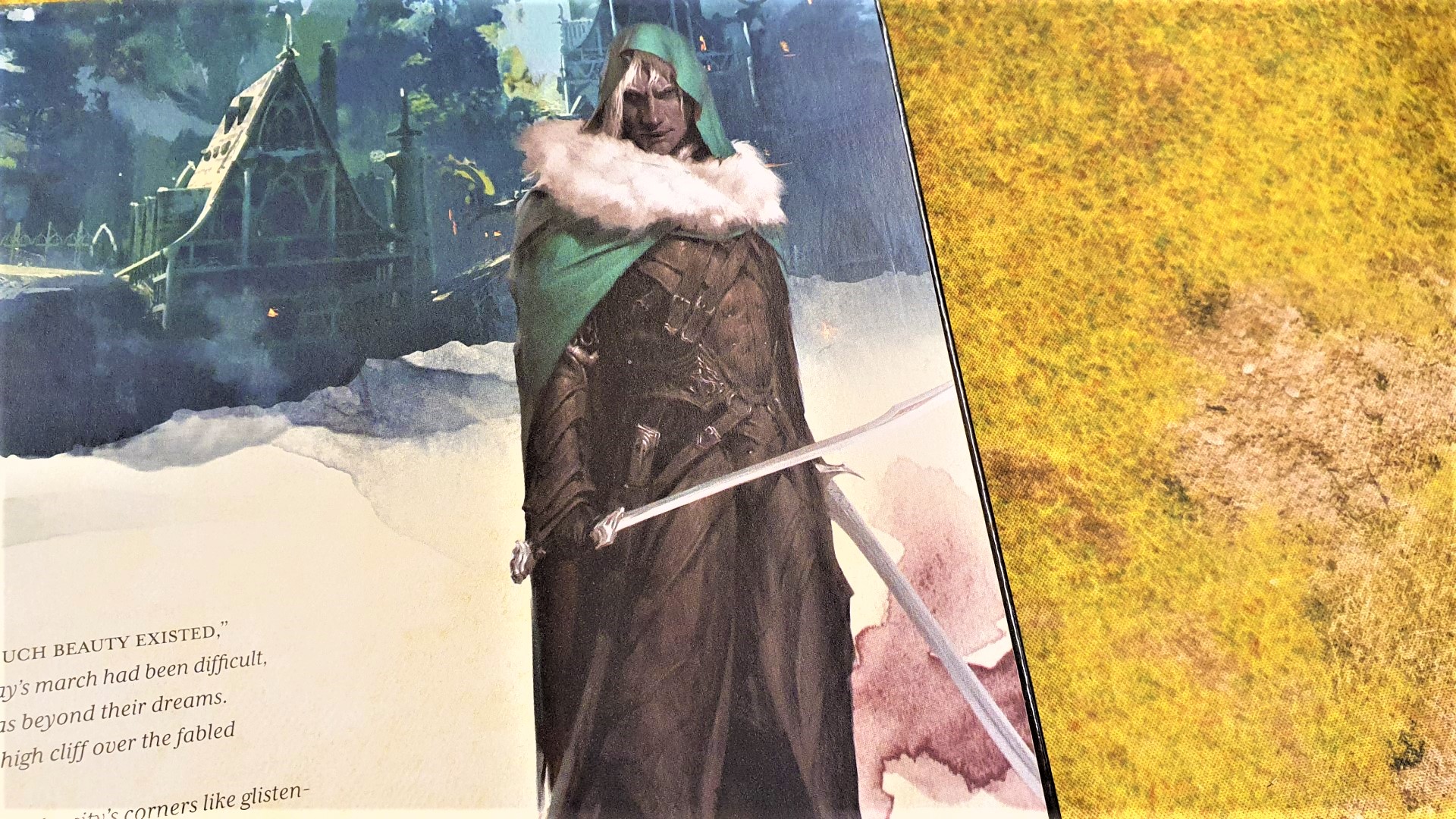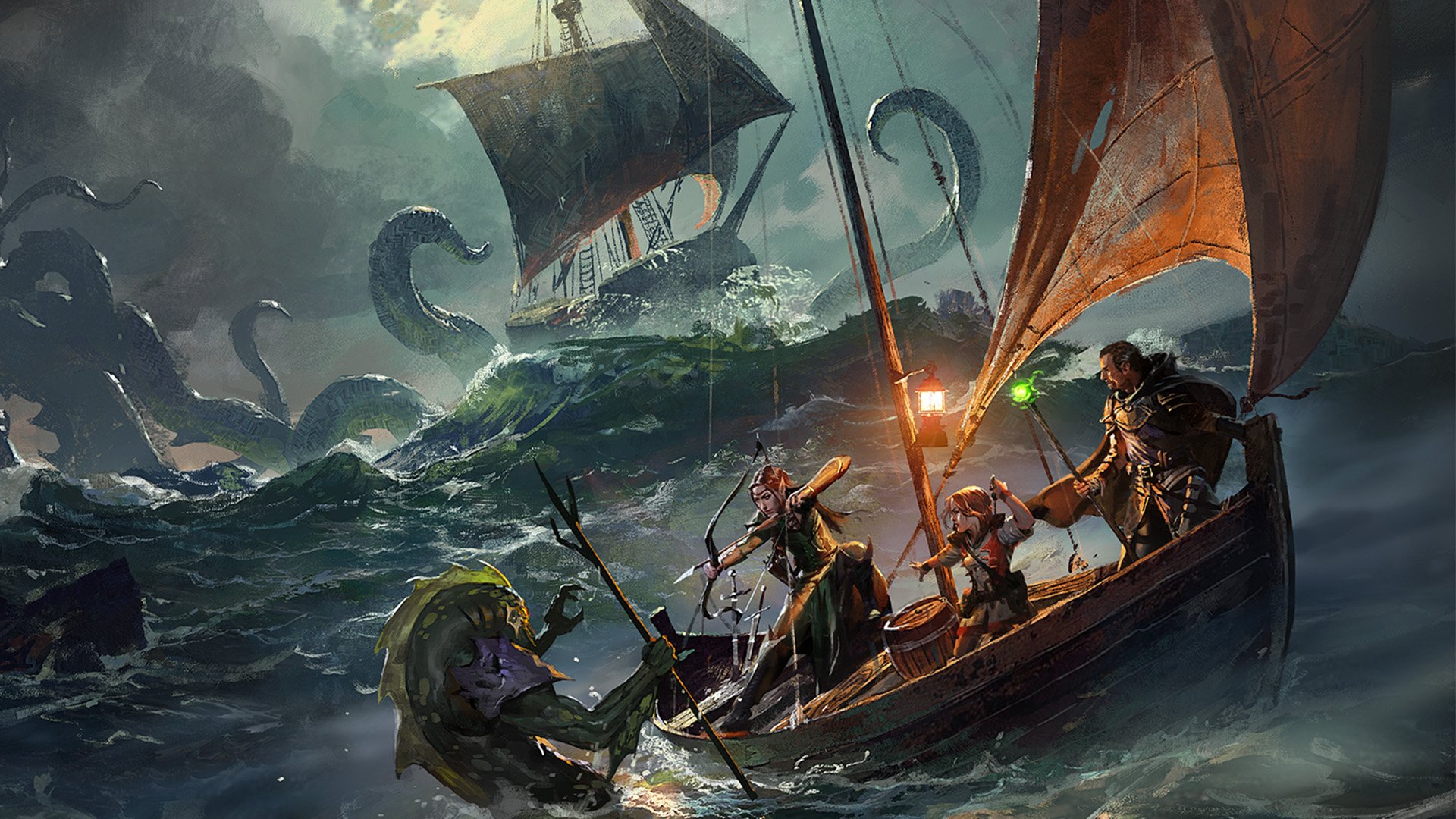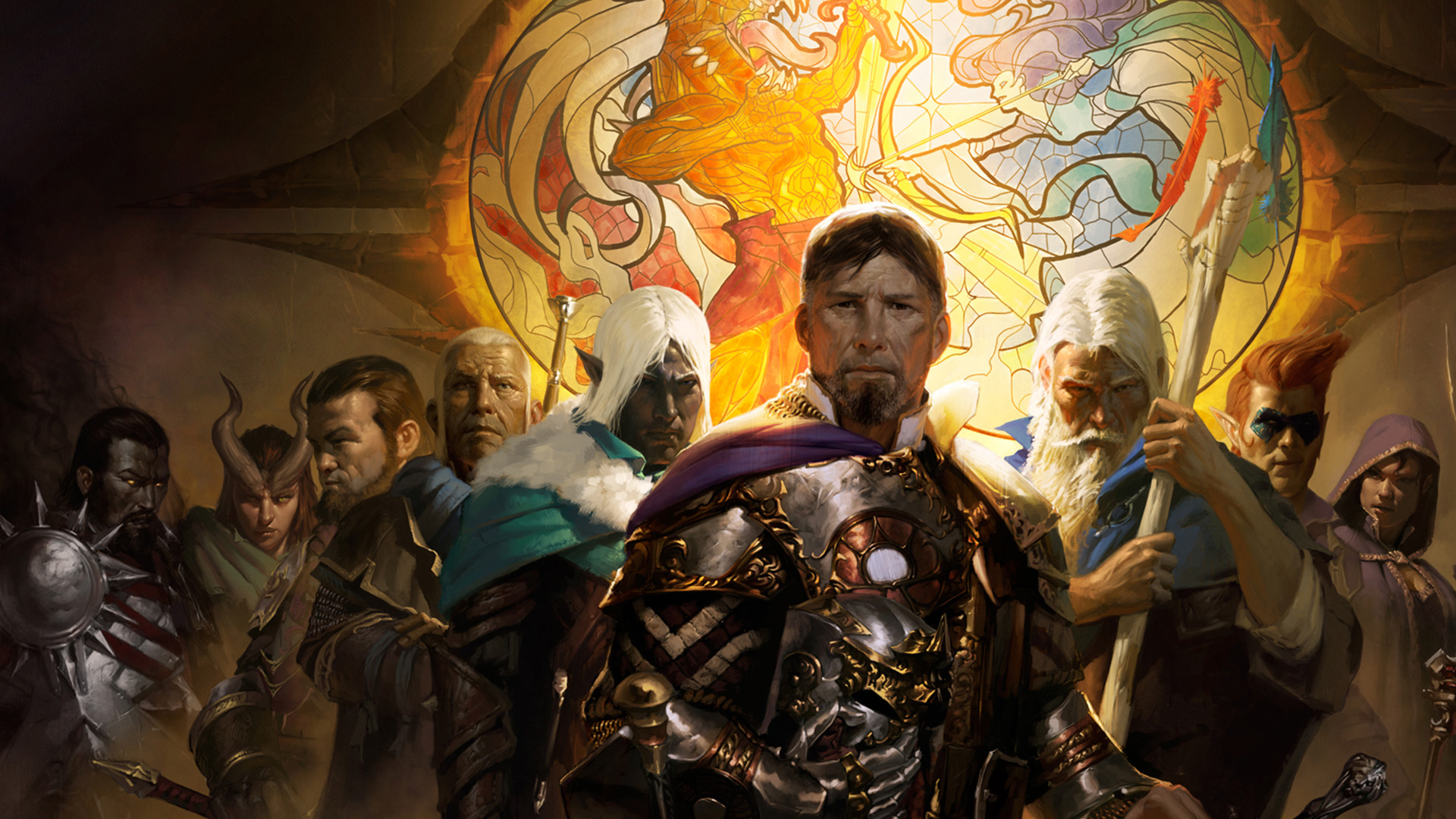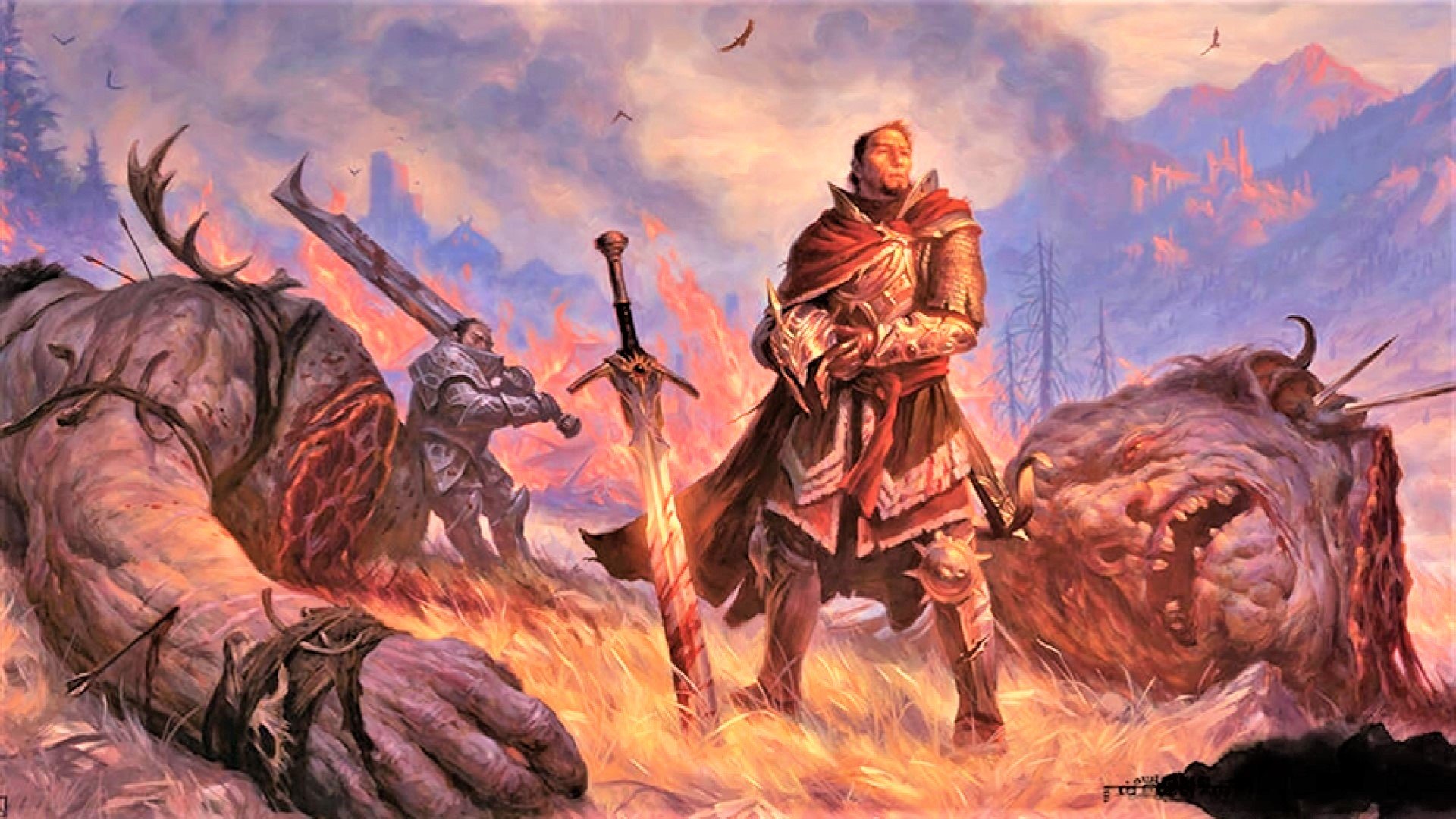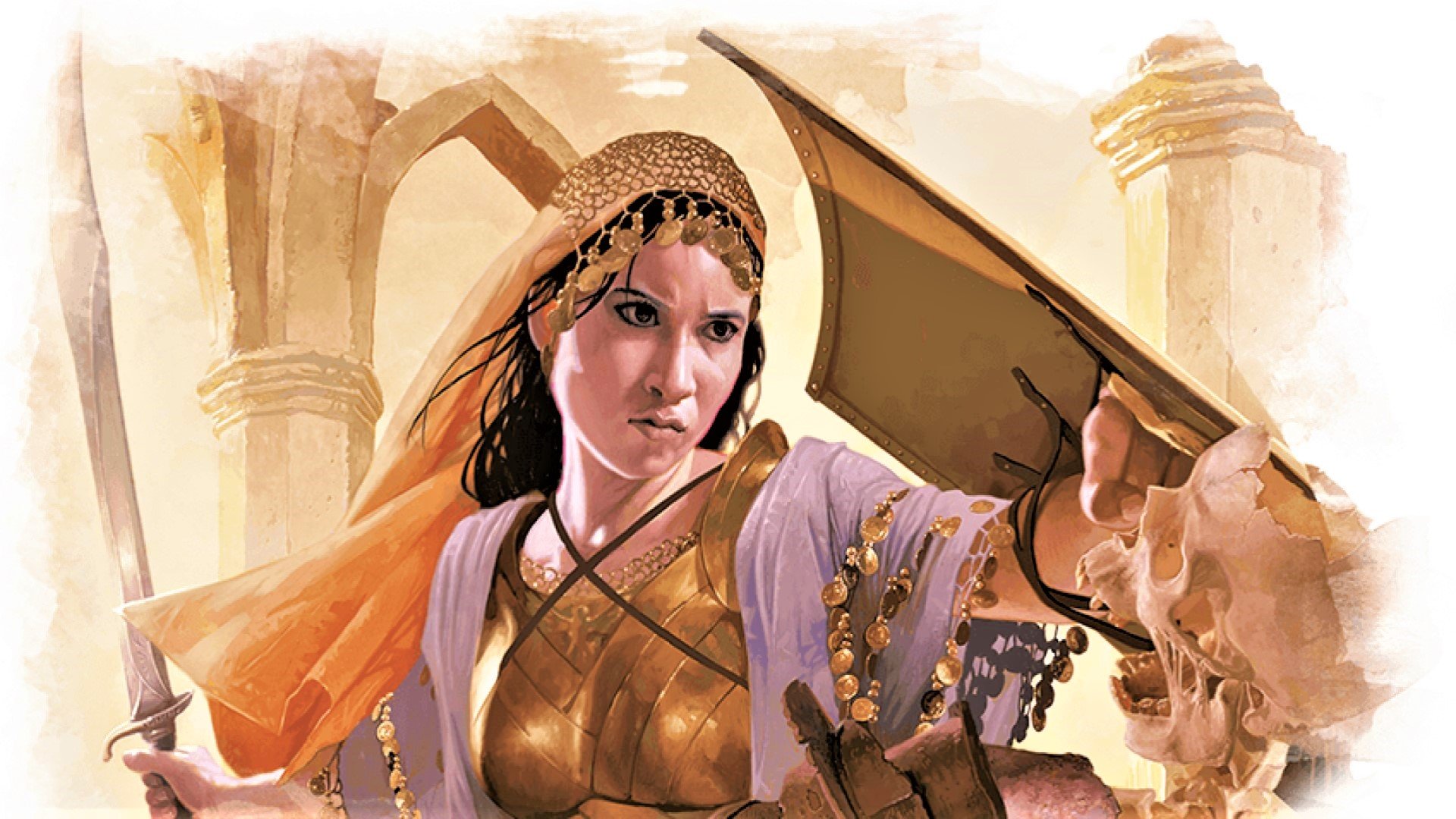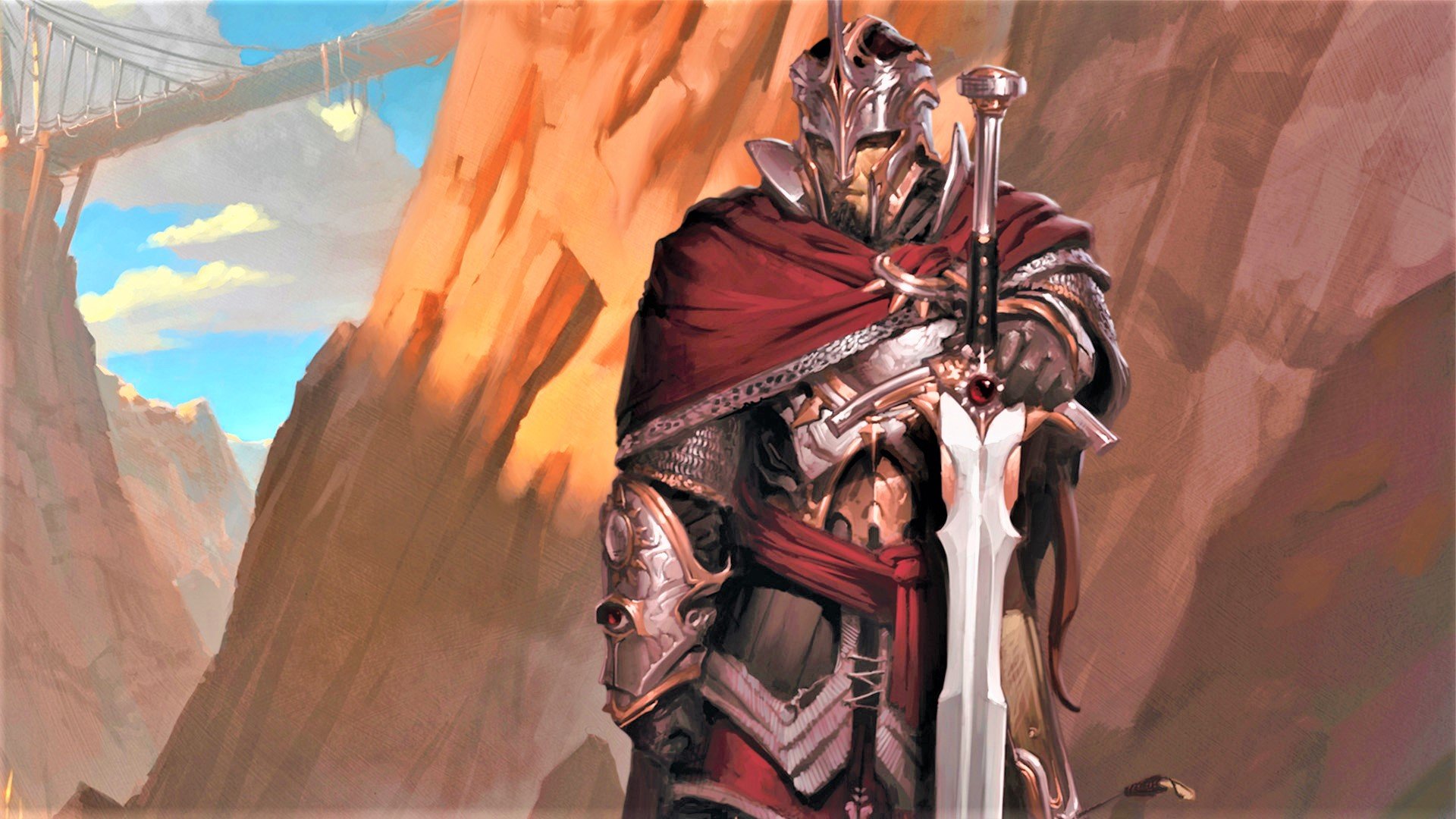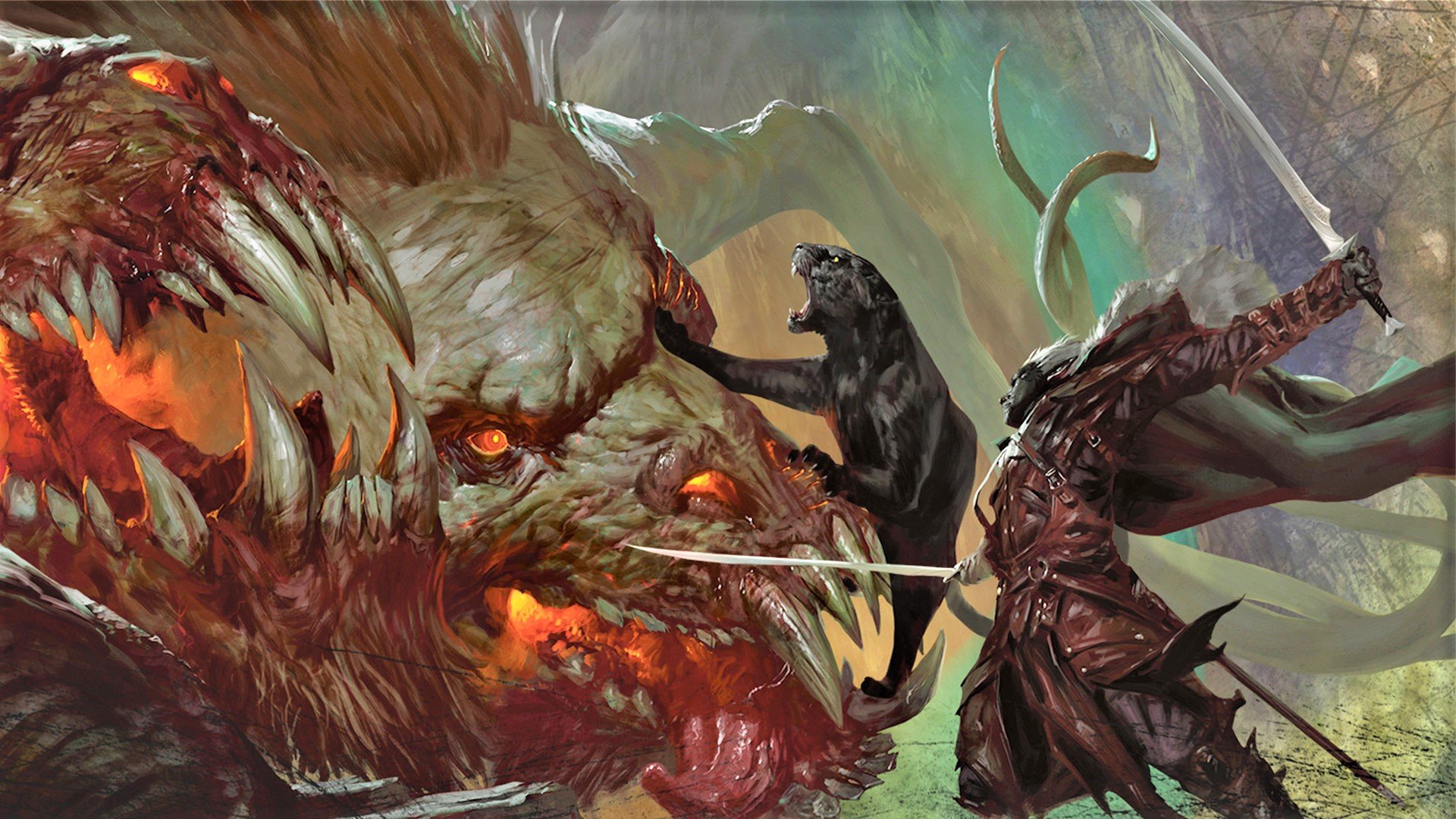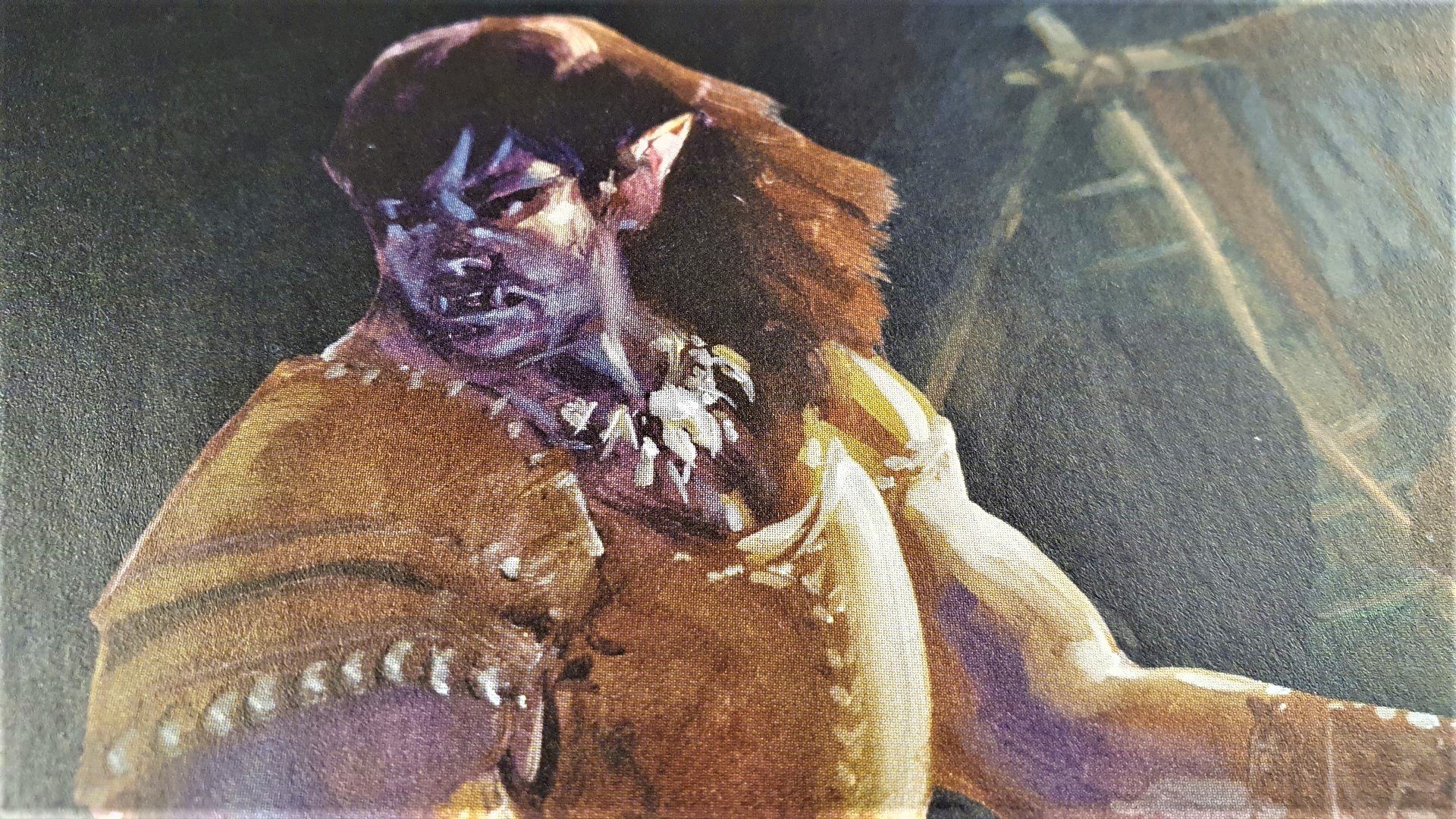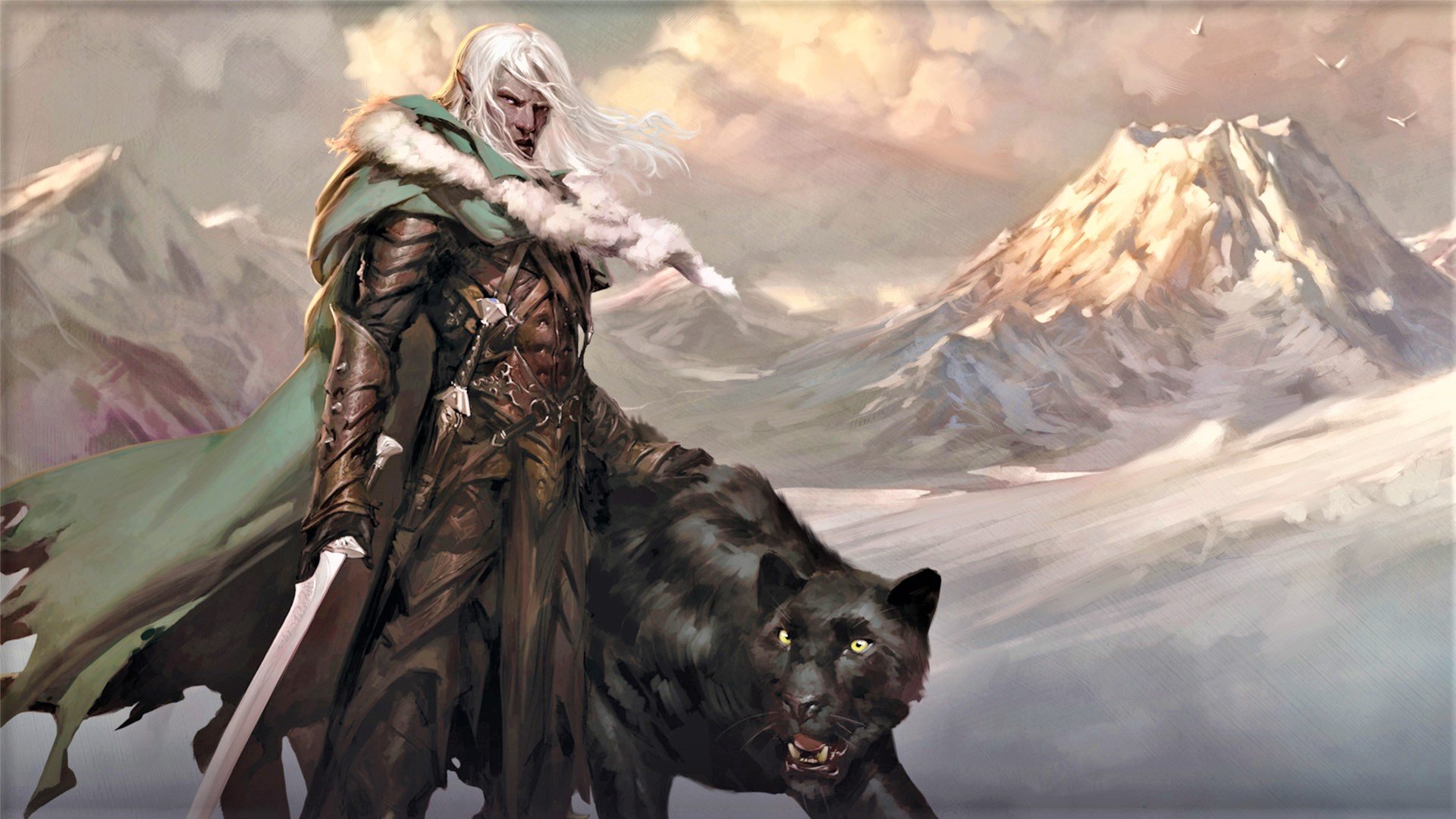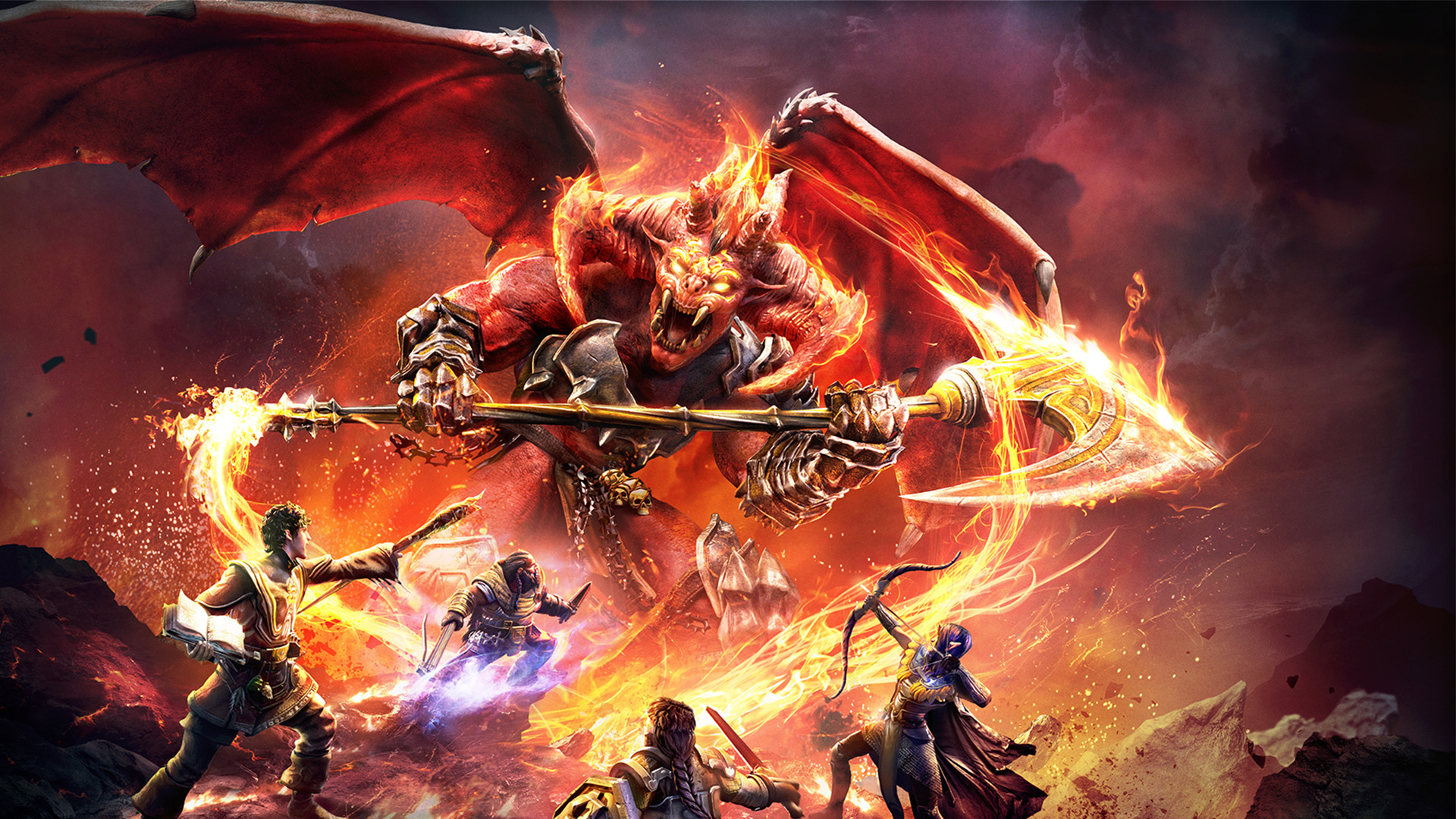The DnD 5e Fighter class is often the first port of call for new players, and it’s easy to see why. With satisfying stand-out class characteristics like choosing a Fighting Style, and their general ability to absolutely lay waste to enemies left and right, it’s hard not to fall in love with D&D when playing them.
But, contrary to popular belief, the Fighter isn’t a newbie exclusive. With their array of exciting class features, diverse and unique archetypes, and addictively powerful damage output, even dungeon-delving veterans can get hooked.
One of the most versatile DnD classes, Fighters are a classic choice for any damage dealing- or tank-inclined roleplayers. The DnD Fighter 5e class perfectly embodies that timeless action hero role, expertly skilled in combat and prepped to save the day.
Here’s our in-depth class guide, offering some guidance for future character creation, a tour through all the Fighter subclasses at your fingertips, and details of some prime DnD character builds, filled with suggestions for DnD races and 5e feats that will let you dominate the battleground during your next adventure. Simply grab a DnD character sheet, and you’re ready to go.
Here’s all you need to know about the DnD Fighter 5e class:
- Fighter 5e stats
- Fighting styles 5e
- Best Fighter 5e races
- Fighter 5e subclasses
- Fighter 5e builds
- Fighter 5e feats
Fighter 5e stats
| Hit dice | 1d10 Per level |
| HP at lvl up | 1d10 (or 6) + Constitution modifier |
| Primary ability scores | Dexterity or Strength and Constitution |
| Armor proficiency | All armor, shield |
| Weapon proficiency | Simple weapons, Martial weapons |
| Tool proficiency | None |
| Saving throws | Strength and Constitution |
The Fighter class generally has two paths players can take. You can choose to be a ranged Fighter, focusing on your Dexterity (Dex) score, or a baddie-bashing melee maniac – which is based around your Strength (Str).
It’s purely up to you which DnD stats to focus on maxing out. However, no matter which type of Fighter you end up picking, remember to raise their Constitution (Con) score, too. After all, you can’t have a beefy damage dealer that gets knocked out at the drop of a helmet, right?
Fighting styles 5e
Right at level one, players will pick a fighting style that will influence how they play the rest of the campaign. This is the class’s iconic ability, and the main reason why so many D&D players choose to multiclass with the Fighter – so make sure you go through all your options, and pick carefully.
These are the fighting styles found in the Player’s Handbook:
- Archery: Perfect for bow-wielding Fighters, and a must for any Dex-focused players. It grants a +2 to attack rolls when using a ranged weapon.
- Great Weapon Fighting: If you’re planning on using some heavy-duty DnD weapons like a Greatsword, this style is essential. When using a two-handed or versatile melee weapon, players can reroll any ones or twos on damage. However, they must use the new result.
- Defense: If you want to absorb some major damage for your party, and fully take on the role of the tank in combat, Defense increases your armor class (AC) – granting a +1 bonus, and making you harder to hit.
- Protection: Players wielding a shield can use their reaction turn to cause an enemy to roll disadvantage when they attack a target. However, this style is only effective in a five-foot range. Overall, it’s a decent pick for Fighters wanting to focus on aiding allies.
- Dueling: Fighters with this Style will gain a +2 bonus to their damage rolls when wielding a single melee weapon in one hand. This also applies when fighters are holding a shield in their other hand, making it a tempting choice for sword-wielding roleplayers.
- Two-weapon Fighting: When using Two-weapon Fighting, Fighters can use their bonus action for a second attack with a different light melee weapon. The style, unsurprisingly, makes fighting with two weapons more effective and lets players rack up some notable damage against enemies.
The following fighting styles are the most recent additions from Tasha’s Cauldron of Everything:
- Blind Fighting: Nothing gets past you, literally. Fighters get blindsight with a ten feet range. Even when blinded or in complete darkness, you can see anything that isn’t behind total cover, meaning no more disadvantage imposed when attacking targets you usually wouldn’t see.
- Unarmed Fighting: You can officially throw down in hardcore fisticuffs as a Fighter. Unarmed strikes deal 1d6 + your Str modifier of bludgeoning damage. If you aren’t wielding any weapons, that d6 turns into a d8. There is also the option to grapple an enemy and deal 1d4 damage at the start of your turn.
- Superior Technique: If you want the perks of playing as a Battle Master subclass, without fully committing, this is a great fighting style to pick. Players can choose one of the many useful and powerful maneuvers from the Battle Master’s list for free.
- Interception: When you are wielding a shield or a martial weapon, if you see a creature attack within a five-foot range, you can use your Reaction to leap in and intercede – lessening their damage roll by 1d10 + your proficiency bonus. This is especially useful if your party has lots of spellcasters with low AC.
- Thrown Weapon Fighting: It acts exactly as it sounds; you can throw a weapon with the ‘thrown’ property. However, it also lets you draw multiple weapons in a turn, and adds a nifty +2 to your damage roll.
Best Fighter 5e races
For an optimal Fighter build, you’ll generally look towards DnD races that will give some juicy bonuses to your key ability scores. Choices that will increase Dex, Str or Con are sure-fire ways to take your characters up a notch.
Mountain Dwarf
Fighters will get a +2 Str and +2 Con. That’s right, a total of four points of score improvements, adding up to one of the best choices for tanks and strength-focused Fighters. You also get some free resistance to poison thrown into the mix. What more could you ask for from a DnD Dwarf?
High Elf
With their +2 bonus to Dex, +1 to Intelligence (Int), dark vision and proficiency in perception, a High DnD Elf makes a super-effective ranged Fighter. Their Intelligence bonus also helps pump up secondary ability scores, to benefit subclasses like the Eldritch Knight. Bear in mind that their Elven Accuracy feat grants a huge damage increase as well, so if you’re planning to be an archer, or a Fighter dabbling in magic, it’s a solid pick.
Dragonborn
This race will give Fighters a +2 Str and +1 to their Charisma (Cha), great for melee players looking to beef up their stats. Dragonborn 5e Fighters also get Breath Weapon, an innate ability that lets you damage multiple enemies at once, getting past the typical and limiting single-target attack styles dominant in the Fighter class.
Variant Human
The Variant DnD Human will let players add a point to any two ability scores of their choice, gain proficiency in any skill that tickles their fancy, and, finally, even grants an extra feat. For any Fighter characters, these perks combined make for a pretty amazing deal.
Half-Orc
Here, you get a +2 Str and a +1 Con, making Half-Orcs great from an ability score perspective straightaway. But what truly makes them stellar picks is their Relentless Endurance and Savage Attack racial abilities, making Half-Orc Fighters tough to take down, while hitting extremely hard.
Fighter 5e subclasses
At level three, players will hone in on their decisions and build upon their chosen fighting style by picking their martial archetype – the Fighter’s term for subclass.
We’ve elsewhere ranked the DnD Fighter subclasses from worst to best, if that’s your bag. If you’re after a straight guide, read on.
There are ten official subclasses for Fighters, each offering their own spin on a combative hero to dig your roleplaying teeth into. Here are all the Fighter 5e subclasses:
- Champion
- Battle Master
- Eldritch Knight
- Arcane Archer
- Echo Knight
- Cavalier
- Samurai
- Banneret / Purple Dragon Knight
- Psi Warrior
- Rune Knight
Champion 5e
| Level | Subclass abilities |
| 3 | Improved Critical |
| 7 | Remarkable Athlete |
| 10 | Additional fighting style |
| 15 | Superior Critical |
| 18 | Survivor |
The simplest of all the subclasses, the Champion 5e is a safe bet for any beginners or players who enjoy handing out mass damage, with a minimum of planning.
At level three, Champions get Improved Critical, making any natural 19 count as a critical roll. As you level up, your crit chance can get up to three times higher than anyone else in your party, and all the double damage you’ll deal will be incomparable.
At level ten, an additional fighting style lets Champion players become more well-rounded or highly specialized, making this class a home run combat wise.
Now, if we’re completely honest, the straight-up-and-down Champion subclass can get a bit dull as you progress in the game. However, it’s still a great choice to experiment with 5e multiclassing, and stands as one of the best archetypes in terms of damage output.
Battle Master 5e
| Level | Subclass abilities |
| 3 | Combat Superiority, Student of War |
| 7 | Know your Enemy |
| 10 | Improved Combat Superiority |
| 18 | Relentless |
If you want to play as a Fighter who backs up deadly combat skills with some good old-fashioned creative tactical thinking, the Battle Master 5e is the subclass to pick.
This archetype comes with a long list of battle maneuvers – powered by your four Superiority Dice – that give players more complexity in combat, and more versatility in playstyle.
Stand-out maneuvers like Trip Attack, which lets you knock enemies prone, giving you advantage on the next three attacks, are game-changers, and let Fighters control the battlefield.
Here is a class that lets you use your smarts, and generally upgrades the Fighter experience for the player. Also, it’s worth noting that you can get all your maneuvers back after a short rest, theoretically letting players use them multiple times in one game day.
Eldritch Knight
| Level | Subclass abilities |
| 3 | Spellcasting, Weapon Bond |
| 7 | War Magic |
| 10 | Eldritch Strike |
| 15 | Arcane Charge |
| 18 | Improved War Magic |
Who doesn’t love popping some nifty spells while in the thick of the battle? The Eldritch Knight 5e is a Fighter who gains access to several DnD Wizard spells, primarily from the DnD schools of magic, Evocation and Abjuration.
They can be thrilling to play, especially during characters’ earlier levels, as they wield magic while bashing all who stand in their way. Their level seven class feature, War Magic, lets you cast a DnD cantrip and use your bonus action to make a weapon attack on the same turn, making each turn feel way more rewarding in combat.
However, this subclass requires players to juggle Intelligence into their ability scores, and spell progression can feel slow. Level-up decisions get harder and harder, so be prepared to spend some time deliberating each choice.
Here’s a handy Eldritch Knight 5e guide to teach you more about this subclass.
Arcane Archer 5e
| Level | Subclass abilities |
| 3 | Arcane Archer Lore, Arcane Shot |
| 7 | Magic Arrow, Curving Shot |
| 15 | Ever-Ready Shot |
| 18 | Improved Arcane Shot |
As you progress in the Arcane Archer 5e subclass, the typical archer image is turned on its head, replaced with fancy tricks and thematic mechanics.
At the seventh level, all your arrows can be imbued with magic. Curving Shot uses your bonus action, letting you redirect arrows to different targets during combat, Wanted-style. If you feel inclined towards taking up a ranged Fighter, this is one of the more stylish choices.
However, be prepared to fully embrace your niche, as Arcane Archers are limited to using a bow. Unlike the other Fighter subclasses that offer a range of versatility, they’re fully locked into their role as a ranged damage dealer.
Echo Knight 5e
| Level | Subclass abilities |
| 3 | Manifest Echo, Unleash Incarnation |
| 7 | Echo Avatar |
| 10 | Shadow Martyr |
| 15 | Reclaim Potential |
| 18 | Legion of One |
What’s cooler than roleplaying as a mysterious Fighter who can summon a temporal duplicate of themselves?
At level three, the Echo Knight 5e can manifest their duplicate to fight alongside them, distract enemies, absorb party damage, and even teleport around the battlefield. If you like summoner gameplay, but want to try your hand at the Fighter, this subclass is a must.
Although the Echo’s abilities are limited outside combat, the Echo Knight is one of the most unusual Fighter archetypes you can play, and is a slap in the face to naysayers who reckon Fighters to be boring or vanilla…
To learn more about this subclass, check out our full Echo Knight 5e guide.
Cavalier
| Level | Subclass abilities |
| 3 | Bonus Proficiency, Born to the Saddle, Unwavering Mark |
| 7 | Warding Manoeuvre |
| 10 | Hold the line |
| 15 | Ferocious Charger |
| 18 | Vigilant Defender |
The image of a mounted knight immediately comes to mind for this subclass, but the truth is that they’re just as effective without a noble steed.
Cavaliers are great for defensive players, and especially for a campaign with lots of squishy spellcasters to look after. They demand more tactical thinking (reminiscent of fourth edition) so they can be incredibly rewarding for long-time players and combat enthusiasts to take on.
At level three, Unwavering Mark lets Cavaliers put enemies at Disadvantage, and gives their own attacks Advantage, if the creature targets one of their teammates. They also can grant extra AC, knock enemies prone, and generally add tons of buffing and protective value to an adventuring party.
Samurai 5e
| Level | Subclass abilities |
| 3 | Bonus Proficiency, Fighting Spirit |
| 7 | Elegant Courtier |
| 10 | Tireless Spirit |
| 15 | Rapid Strike |
| 18 | Strength before Death |
One for the Overwatch Genji mains – if you like being the party’s striker, and thrive on an offensive playstyle, the Samurai 5e is for you.
Their Fighting Spirit ability lets players use their bonus action to gain more Hit Points, as well as an Advantage on all their attacks. It’s a pretty decent feature, but has limitations – as you can only use it three times before having to take a long rest. At level 15, Rapid Strike lets you forgo your Advantage for an additional attack, allowing players to absolutely wail on enemies with abandon.
Where Samurai shine most is in the higher levels, when Rapid Strike truly comes into its own. Still, since Fighters can gain Advantage in multiple ways, Fighting Spirit’s three-per-day limitation can feel jarring, especially for seasoned players.
Banneret / Purple Dragon Knight 5e
| Level | Subclass abilities |
| 3 | Rallying Cry |
| 7 | Royal Envoy |
| 10 | Inspiring Surge |
| 15 | Bulwark |
| 18 | Improved Inspiring Surge |
The Purple Dragon Knight 5e (also called the Banneret, outside of the Forgotten Realms DnD setting) acts as something of a commander during their campaigns. Their abilities add a lot of support in battle, and they are masters of persuasion.
Rallying Cry activates when they use their Second Wind power, granting hit points equal to their Fighter level to all allies in range. Their other ability, Inspiring Surge, lets a chosen ally use their Reaction to perform a full-on attack.
There is a lot of crossover with the Battle Master subclass’s maneuvers here, but with less versatility and power, making this subclass a tough sell among its peers. However, if you want to roleplay as a charismatic Fighter, The Purple Dragon Knight is worth looking into.
Psi Warrior
| Level | Subclass abilities |
| 3 | Psionic Talent, Psi Replenishment |
| 7 | Telekinetic Adept |
| 10 | Psi-Enhanced Metabolism |
| 15 | Bulwark of Force |
| 18 | Telekinetic Master |
Ever wanted to be a Jedi traversing through the Forgotten Realms? Well, playing as a Psi Warrior will probably be as close as you’ll get.
Like the Eldritch Knight, they combine melee with magic – but Psi Knights also have a mechanic similar to the Battle Master’s superiority dice, when using their Psionic powers. Along with mimicking aspects from these subclasses, they’re a lot easier to play in general, thanks to their fixed set of built-in options.
Unfortunately, players will need to pay extra attention to their ability scores, as Psi Warriors’ powers – like Eldritch Knights’ spells – are often dependent on Intelligence.
Rune Knight 5e
| Level | Subclass abilities |
| 3 | Bonus proficiency, Rune Carver, Giant’s Might |
| 7 | Runic Shield |
| 10 | Great Stature |
| 15 | Master of Runes |
| 18 | Runic Juggernaut |
The Rune Knight 5e enhances their equipment through the use of ancient runes passed down from Giants. A general note to remember is that players of this subclass will want to focus on their Con score to power their rune magic effectively.
This subclass makes a great tank option. With abilities like Runic Shield (which forces enemies to reroll attacks) and Giant’s Might (which lets them apply extra damage), these folks can be invaluable party members.
Rune Knights are a powerful subclass, both in the early and late games – but require resource management skills to unlock their full potential.
Fighter 5e builds
Now that you’re familiar with how the Fighter performs on paper, here are some play-tested DnD character builds to help you put yours together.
Elven Samurai
For the Overwatch Hanzo mains. When you think about a traditional image of a Samurai, an Elven archer may not immediately come to mind, but hear us out; it’s totally worth it.
A Dex-focused Samurai that has the Elven Accuracy feat, paired with Sharpshooter, is terrifying. The mass damage they can deal in a single turn, plus their Rapid Strike ability, will let players dominate combat.
Ability scores
You’ll want to max out your Dex as soon as possible. Focus on Con next, but (and we can’t stress this enough) your Dex directly impacts damage scaling, and is by far the most important to pay attention to as you keep levelling.
Details
- Pick the High Elf race, giving you +2 Dex, the Elven Accuracy feat and Dark Vision.
- Take a longbow for your primary weapon and choose the Archery fighting style. This will give a bonus to your ranged attacks.
- At the third level, once you pick the Samurai subclass, you will gain the option for a bonus proficiency. Persuasion is a good choice that meshes well with the Samurai archetype, which leans more into being the party face and charismatic Fighter.
- At level four, take the Sharpshooter feat. This feat, paired with the Samurai’s Fighting Spirit ability, is deadly. Fighting Spirit’s Advantage, paired with Sharpshooter’s damage bonus, likewise equals mind-blowing power in early levels.
- At level six, take the Elven Accuracy feat; this will give a bonus to an ability score of your choice and attack rerolls. Now you get to roll three dice when you have Advantage, further increasing your chance to hit, crit and attack.
- At level eight, you get an ability score improvement. Here you will want to max out your Dex if you haven’t already.
- From here on out, the core build is pretty much in place, and the rest of the build’s decisions can be catered especially to each player’s roleplaying preferences.
Human Polearm Battle Master
The sentinel Polearm Master often comes up when talking about optimized builds in D&D 5e. It’s an option that does a lot – and we mean a lot – of damage.
You can weaponize both your Bonus Actions and Reactions, attack from a distance, and keep enemies at bay. They are one of the strongest melee builds in the game, and can be an overpowering force on the battlefield.
Ability scores
You’re going to be a heavy weapon Fighter, so, naturally, your character is going to need a pretty sizable Str score, closely followed by Con. Your secondary focus, after maxing these, should be your Dex.
Details
- Choose the Human Variant Race, and with their free feat, take Polearm Master; this will give extra bludgeoning damage to your attacks. Use their ability score bonus for your Str and Con.
- You will want to take a Reach weapon in this build. Choose a glaive or halberd, and get some heavy armor to top it off.
- For your fighting style, pick Great Weapon Fighting; this will give you the option to reroll any annoying ones or twos for better damage. This, paired with the bonus from the Polearm Master feat, makes you pretty scary straight away.
- At level three, pick the Battle Master archetype, giving you three maneuvers. They are all pretty good; however, we recommend picking Menacing Attack for a further 1d8 bludgeoning damage, and Lunging Attack to extend your reach.
- At level four, take the Sentinel feat; this will stop in-range enemies’ movements completely, and gives tons of chances for opportunity attacks.
- At level seven, you get more maneuvers; if you’re unsure about which ones to pick, Trip Attack is always a great choice.
- From here, all you need to do is keep raising your ability scores, and add to your maneuvers list. Once you gain that Sentinel feat, you’re pretty much sorted.
Two-Hander Half-Orc Champion
If you live for landing multiple crits and stacking up that sweet, sweet damage, here is the build for you. Two-hander Champions are all about maximizing each attack by hitting very hard, aiming to strike down foes in a single turn.
They are incredibly satisfying to play in combat, and an excellent introduction for the Fighter class in general. I mean, what else can get players into the roleplaying mood more than obliterating enemy creatures with a single swing of a giant sword or hulking ax?
Ability scores
Like the Polearm Master, you will be handling heavy weapons, so raising your Str will be your priority. Two-hander Champions will also need to raise their Con, as they’ll probably be in the frontlines, taking hits from enemies.
Details
- Pick the Half-Orc race. This will give your Fighter +2 Str and +1 Con. You will also get access to the Savage Attack power.
- For weapons, Fighters should take a Greataxe, as, when paired with the Half-Orc’s Savage Attack ability, this will give you an additional bonus on any critical hits. Paired with the Champion’s subclass feature of an extra critical chance, this becomes super-powerful
- The Great Weapon fighting style is a must, letting Fighters increase their crit damage even further.
- At the third level, the Champion archetype will give players an increase to their critical rate with Improved Critical, letting your Fighter deal out more damage.
- At Level four, take the Savage Attack feat. This will let you roll damage dice again on a critical hit.
- Level six gives players another feat or ability score improvement. Pick the Lucky feat to roll an additional d20.
- Finally, at level ten, you will have the chance to pick an additional fighting style. Here, it depends on your party role. A good shout would be taking Protection to aid allies, making enemies roll with Disadvantage after a hit. Or take Defense to boost up your AC, making it even harder to take you down.
- By following this core build, you will be landing a lot of critical rolls, and dishing out scary amounts of damage.
Fighter 5e feats
Your first focus should be maxing out either your Str or Dex for powerful Fighters, then raising your Con. However, if your abilities are already maxed out, here are the best 5e feats for your Fighter to grab when leveling up.
Great Weapons Master
A must for melee Fighters using two-handed weapons. This feat gives Fighters a bonus action any time they get a critical or kill an enemy. It can also increase damage output, as players get the option to take a -5 penalty to their attack roll in exchange for +10 to their damage roll.
Shield Master
This allows Fighters to use their shields to knock back enemies. They can also use their shield’s AC to assist in any saving throws.
Sharpshooter
This is essential for ranged Fighters. Sharpshooter prevents disadvantage being applied to any long-ranged attacks. It also offers an increase in overall damage, as Fighters get the option to take a -5 to-hit penalty, for a potential +10 to their damage rolls.
Resilient
With this feat, Fighters get to increase an ability score, and then gain Proficiency in saving throws for that ability. This can be useful in boosting your Fighter’s Wisdom (often a weak area for Fighters), generally making it harder for spellcasters to charm or control your character.
Crossbow Expert
If Fighters are carrying a loaded crossbow, this lets them use it for a bonus attack, any time they make an attack with a one-handed weapon in combat. What Fighter doesn’t want an extra opportunity to deal more damage?
One DnD Fighter changes
With One DnD coming out in 2024, all the classes are about to be shaken up. But the Fighter is one of the classes that’s seeing the least change between base 5e rules and One DnD.
Still, that doesn’t mean it’s staying completely the same. There are plenty of tweaks to be aware of for the One DnD Fighter.
For instance, the Fighter is the class who benefits most from the new Weapon Mastery system, a feature that gives you an extra special move with a weapon, like knocking an enemy prone or cleaving to a second opponent. The Fighter gets to have masteries for more weapons than any class, starting out with three and ending up with six. You’ll need to have a backpack stuffed full of pointy things!
Other changes include the ability to switch your Fighting style feat between levels. Second Wind has been boosted, so you can use it multiple times between rests, and there are all sorts of tweaks for the various Fighter subclasses.
Originally, Wizards of the Coast planned to create a brand new Fighter subclass, the unarmed Brawler. However, this fared poorly in playtests, and was soon scrapped by the designer.
Ready to get fighting? Here’s some more tools you might want to use in your next DnD campaign. We can recommend the best DnD miniatures – or, if you like things simpler, here’s our DnD campaign case review.
